

The Secret Files of the Master of Modern Republican Gerrymandering. Hofeller did not follow his own advice.
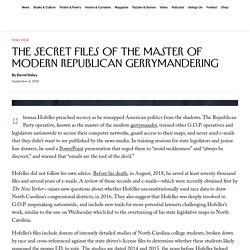
Before his death, in August, 2018, he saved at least seventy thousand files and several years of e-mails. A review of those records and e-mails—which were recently obtained first by The New Yorker—raises new questions about whether Hofeller unconstitutionally used race data to draw North Carolina’s congressional districts, in 2016. They also suggest that Hofeller was deeply involved in G.O.P. mapmaking nationwide, and include new trails for more potential lawsuits challenging Hofeller’s work, similar to the one on Wednesday which led to the overturning of his state legislative maps in North Carolina. Hofeller’s files include dozens of intensely detailed studies of North Carolina college students, broken down by race and cross-referenced against the state driver’s-license files to determine whether these students likely possessed the proper I.D. to vote.
Other files provide new details about Hofeller’s work for Republicans across the country. Quasi-Experimental Research – Research Methods in Psychology. Explain what quasi-experimental research is and distinguish it clearly from both experimental and correlational research.Describe three different types of quasi-experimental research designs (nonequivalent groups, pretest-posttest, and interrupted time series) and identify examples of each one.
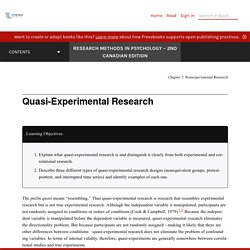
The prefix quasi means “resembling.” Thus quasi-experimental research is research that resembles experimental research but is not true experimental research. Although the independent variable is manipulated, participants are not randomly assigned to conditions or orders of conditions (Cook & Campbell, 1979). Because the independent variable is manipulated before the dependent variable is measured, quasi-experimental research eliminates the directionality problem. Scientific Method. Scientific Method Flowchart. PresserEtAl 2004 MethodsForTestingAndEvaluatingSurveyQuestionsChapt1. Instrument design webinar handout. 2.1 Psychologists Use the Scientific Method to Guide Their Research.
Learning Objectives Describe the principles of the scientific method and explain its importance in conducting and interpreting research.Differentiate laws from theories and explain how research hypotheses are developed and tested.Discuss the procedures that researchers use to ensure that their research with humans and with animals is ethical.

Psychologists aren’t the only people who seek to understand human behavior and solve social problems. Philosophers, religious leaders, and politicians, among others, also strive to provide explanations for human behavior. But psychologists believe that research is the best tool for understanding human beings and their relationships with others. Cosmos on Nautilus: Is Dark Matter our Generation's Ether? Patton2003. 3298 Patton Chapter 1.
Ethnography: Ellen Isaacs at TEDxBroadway. Tuskegee Study - Timeline - CDC - NCHHSTP. 1895 Booker T.
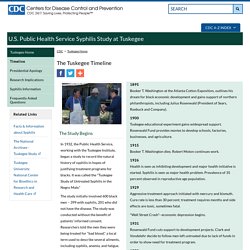
Washington at the Atlanta Cotton Exposition, outlines his dream for black economic development and gains support of northern philanthropists, including Julius Rosenwald (President of Sears, Roebuck and Company). 1900 Tuskegee educational experiment gains widespread support. Rosenwald Fund provides monies to develop schools, factories, businesses, and agriculture. 1915 Booker T. Washington dies; Robert Moton continues work. 1926 Health is seen as inhibiting development and major health initiative is started. 1929 Aggressive treatment approach initiated with mercury and bismuth. "Wall Street Crash"--economic depression begins. 1931 Rosenwald Fund cuts support to development projects. 1932 Follow-up effort organized into study of 399 men with syphilis and 201 without. 1934 First papers suggest health effects of untreated syphilis. 1936 Major paper published. 1940 Efforts made to hinder men from getting treatment ordered under the military draft effort.
About the USPHS Syphilis Study. Where the Study Took Place The study took place in Macon County, Alabama, the county seat of Tuskegee referred to as the "Black Belt" because of its rich soil and vast number of black sharecroppers who were the economic backbone of the region.
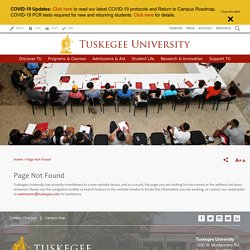
The research itself took place on the campus of Tuskegee Institute. What it Was Designed to Find Out The intent of the study was to record the natural history of syphilis in Blacks. Tuskeegee, Guatemala... By BAR editor and senior columnist Margaret Kimberley The Nazi “Doctor of Death,” Joseph Mengele, lived out his last years in hiding and infamy in South America.

But the American Dr. Mengele, Dr. John C. Chuck Palahniuk Interview. Mr.

Nothingnerdy - Natural Sciences. Back to HOME > IB ToK UNDERSTANDING SCIENCE 101 - good examples and definitions for your essays and presentationsSYMPHONY OF SCIENCE: POETRY OF REALITYTHE AQUATIC APE THEORY - example of unorthodox interpretation of evidence THE POWER OF THEORY FROM SCIENTIFIC AMMERICAN GUEST BLOG - ETHAN SIEGEL FROM THE TOK STUDY GUIDE: "The natural sciences reflect a concerted effort on the part of humans to search for understanding of the world.

Like any other human endeavour, the development of scientific knowledge forms a web with more practical, even everyday, interests and concerns. The natural sciences are recognized as a model for knowledge owing to many factors, prime among which is their capacity to explain and make precise predictions. Scientific Method History. Who Invented the Scientific Method?

Who Discovered the Scientific Method? No one person can be credited as the inventor of the scientific method. It was really not “invented” but recognized and developed as the natural method of obtaining reliable knowledge. History of the Scientific Method Many authors trace the beginning of the scientific method and experimenting back to ancient artisans, Greeks, Arabs, Spaniards, and others. Aristotle Scientific Method. The Scientific Revolution - Definition - Concept - History. Professor Robert A.
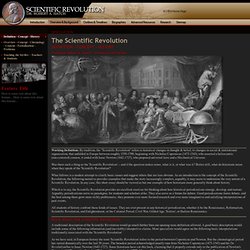
Hatch - University of Florida Working Definition: By tradition, the "Scientific Revolution" refers to historical changes in thought & belief, to changes in social & institutional organization, that unfolded in Europe between roughly 1550-1700; beginning with Nicholas Copernicus (1473-1543), who asserted a heliocentric (sun-centered) cosmos, it ended with Isaac Newton (1642-1727), who proposed universal laws and a Mechanical Universe. Was there such a thing as the 'Scientific Revolution' -- and if the question makes sense, what is it, or what was it?
Better still, what do historians mean when they speak of the 'Scientific Revolution'? What follows is a modest attempt to clarify basic issues and suggest others that are less obvious. Which is to say, the Scientific Revolution provides an excellent exercise for thinking about how historical periodizations emerge, develop, and mature. PSYCH202B: Research Methods Lab. Research Randomizer Tutorial. Gapminder: Unveiling the beauty of statistics for a fact based world view. - Gapminder.org.
Choosing Statistical models. T-Tests, Chi-squares, Phi, Correlations: It’s all the same stuff. DataLoading & Visualization Slicer4.1. RStats Resources - RStats Institute. Statistics Tutoring Undergraduate students who need assistance with statistics homework can receive one-on-one tutoring through Missouri State University's Bear CLAW (Center for Learning and Writing). Click here to access Bear CLAW Statistics Tutoring. Instructional Videos Tables and Calculators Click here to access: Normal Distribution TableT Distribution TableCritical Pearson's r ValuesF Distribution TableChi Square Distribution Table and CalculatorCohen's D Effect Size Calculator Notes from Previous RStats Workshops.
MMPI1-2 Methods. Methodological Problems and Issues in MMPI, MMPI—2, and MMPI—A Research Department of Psychology University of Minnesota, Minneapolis Department of Psychology Kent State University Department of Psychology Kent State University Personality questionnaires are among the most versatile and user-friendly approaches to personality assessment. This article focuses on methodological considerations in conducting research on the Minnesota Multiphasic Personality Inventory–2 (MMPI—2; J. N. Butcher, W. Personality assessment by the questionnaire method has a long history in psychology–dating to Francis Galton at the end of the 19th century. The ability to use self-report measures in psychology is dependent on the quality of the data respondents provide.
Can the MMPI-2 validity scales detect depression ... [Assessment. 2000. Kuhn's Paradigms. (Note: This was originally written and intended for an exam in a graduate course in philosophy.) Thomas Kuhn is remembered for his infamous introduction of "paradigms" to philosophy of science. Essential to every paradigm is the process of "normal science," but paradigms can also shift via a scientific "revolution. " It is Kuhn’s premise that science does not build upon itself in a linear progression, but by leaps and bounds; and, such progressions are not dictated by empiricism alone, but by a mixture of elements contained within a paradigm.
In this essay, I address the role of Kuhn’s paradigm in science, and specifically at how a paradigm allows normal science to do its job, and the importance that normal science has to the scientific discipline. To understand Kuhn, one must understand a paradigm. Questions and answers about language testing statistics: Effect size and eta squared. Shiken: JALT Testing & Evaluation SIG Newsletter Vol. 12 No. 2. Apr. 2008.
(p. 38 - 43) [ISSN 1881-5537] PDF Version. Agricultural Labor Management Articles. Internet Laboratory for Empirical Network Science (iLENS) Project Summary Effective Internet measurement raises daunting issues for the research community and funding agencies. Improved understanding of the structure and dynamics of Internet topology, routing, workload, performance, and vulnerabilities remain a disturbingly elusive priority, in part for lack of largescale distributed network measurement infrastructure available to scientific researchers. The dearth is understandable; measurement of operational Internet infrastructure involves navigating more complex and interconnected dimensions than measurement in most scientific disciplines: logistical, financial, methodological, technical, legal, and ethical.
CAIDA has been navigating these challenges with modest success for fifteen years, collecting, coordinating, curating, and sharing data sets for the Internet research and operational community in support of Internet science. Management Plan. In Experiments We Trust: From Intuit to Harrah’s Casinos. Regular readers of MIT Sloan Management Review will recognize the name Gary Loveman. Critical Thinking FAQ. Hofling's Hospital Experiment of Obedience. Free Beer: The truth about dishonesty. 40 years of federal nutrition research fatally flawed.